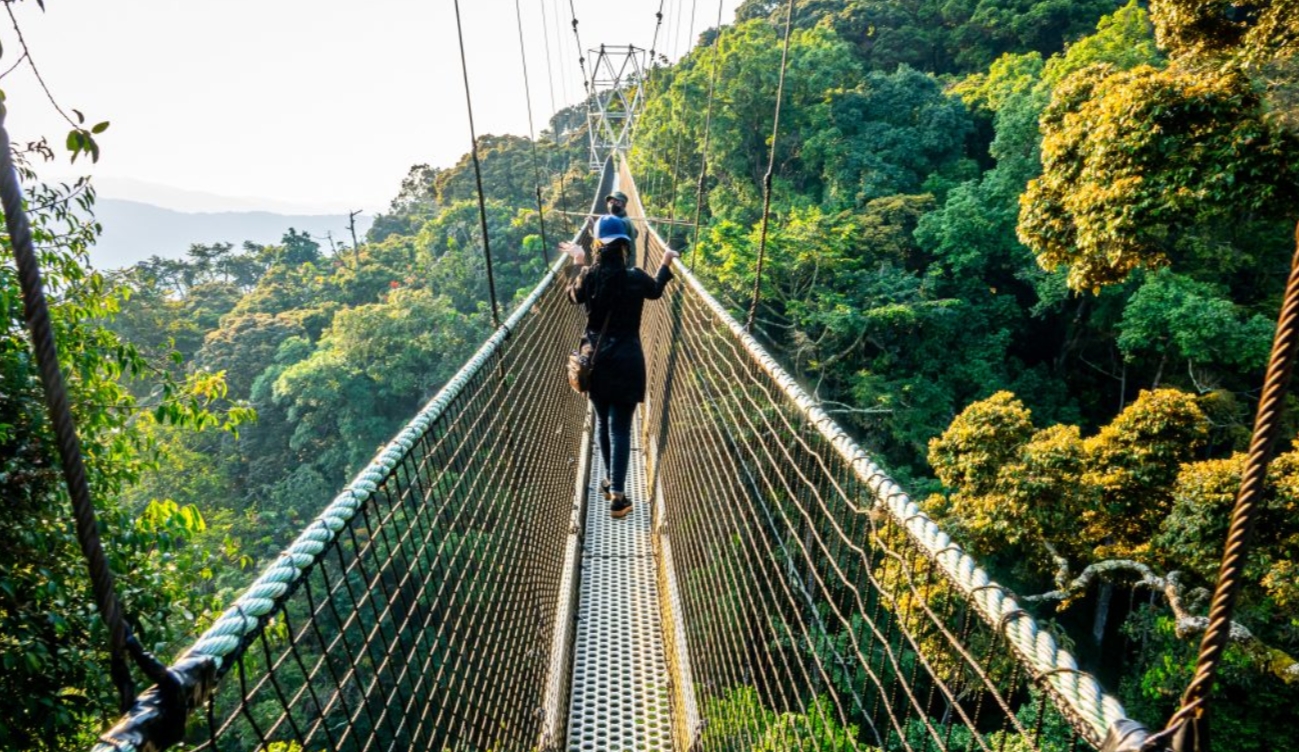
The Beauty of Nyungwe National Park
The Beauty of Nyungwe National Park: This is a staggeringly Rwanda’s most popular tourist sites, located in the southwestern part of the country. It shares boundaries with Lake Kivu to the west, and closer to the Democratic Republic of the Congo. It is one of Africa’s most notable old montane forests famous for its unique and rich biodiversity. It’s drainage catchment zone lies at the centre of the Congo River and the Nile basin in the eastern part. It is famous for its amazing chimpanzee population and offers primate lovers the best chimpanzee tracking adventures.
As part of the country’s conservation efforts, this green jungle was established in 2004 to preserve its distinctive environment. The forest covers more than 1,019 km² and includes grassland, bogs, bamboo, wetlands, and tropical rain forest. The Rwanda Development Board, the nation’s independent wildlife authority, agreed with African Parks in October 2020 to manage it for the first 20 years.
The Beauty of Nyungwe National Park
In recognition of its wide variety of wildlife, Nyungwe Forest National Park is a pioneer in African wildlife conservation. Numerous terrestrial or earthly biomes span a wide range of microhabitats for numerous plant and animal species, and this dense forest is ideally situated where various large-scale biogeographical transition zones converge.
Following the beauty of Nyungwe National Park, more than 13 primate species may be found in the park, accounting for 25% of all primates in Africa. The park is home to diverse wildlife species with over 85 mammals, 300 species of birds, of which 30 are endemic to the Albertine Rift several plant species, amphibians and reptiles, among others.
In the broader Albertine Rift, this forest is home to the greatest number of endemic species.
The forest, which stands at a maximum altitude of 3,000 m (9,800 ft), is of particular interest for the presence of colonies of chimpanzees and other primates such as mountain colobus and Angola colobus (Colobus angolensis); the latter is now near extinction, especially in Angola, due to the intense hunt to which they are subjected.
Primate species
Following the beauty of Nyungwe National Park, several rare primate species can be found in Nyungwe Forest National Park, such as Olive baboon (Papio anubis), Vervet monkey (Chlorocebus pygerythrus), Common Chimpanze (Pan troglodytes), Olive baboon (Papio anubis), the Vervet monkey (Chlorocebus pygerythrus), the Grey-cheeked mangabey (Cercopithecus ascanius), the Hamlyn’s monkey (Cercopithecus hamlyni), Golden monkey (Cercopithecus kandti), Grey-tailed monkey (Cercopithecus l’hoesti), Ruwenzori colobus (Colobus angolensis ruwenzori), the Dent’s mona monkey (Cercopithecus denti), Hamlyn’s monkey (Cercopithecus kandti), L’Hoest’s monkey (Cercopithecus l’hoesti), and others.
During the 1920s, colonial leadership had been concerned about the rising shifts from forest to pastureland. The country’s laws governing its forest reserves interdicted clearing forest land for agriculture but empowered the community with rights to get firewood with valuable exploitation of hardwood timber for commercial purposes. The enforcement was neglectful, and instead the community went further to use the forest for farming, hunting, mining, honey collection, cutting wood, and others.
The Belgian colonial administration then gazetted Nyungwe Forest Reserve as a forest reserve in 1933, enhancing the park’s function in preserving the ecology and its diverse fauna in the nation and the area.
The Ministry of Agriculture was in charge of Rwanda’s forest reserves after the country gained independence in 1962. Nyungwe Forest was reduced to roughly 150 km² between 1958 and 1973 as a result of fire outbreaks and human activities like farming and hunting.
Economic Impact
Following the beauty of Nyungwe National Park, the park is a majorly contributes to Rwanda’s economy, bringing in about $4.8 billion a year. A private company by names of African Parks, was empowered to take over, manage and oversee Nyungwe National Park, in order to save the country’s wildlife, attract foreign investment, and advance sustainability in the tourism sector.
However, there are currently initiatives to promote longer stays and higher expenditures, with resident travellers making up an estimated 40–50% of tourists and foreign visitors making up about 35–40%. This revenue supports sustainable tourism and conservation programs, such as stability, infrastructure development, and employment opportunities, with a long-term plan focusing on balancing revenue together with environmental management.
Conclusion
Following its rich biodiversity, including its outstanding primates particularly chimpanzees standout as the the park’s highlight, makes it one of the country’s top tourist destinations. Nyungwe Forest National Park has priortised to greatly support the country’s economy, and infrastructural development, in the tourism industry. As such, it is prioritised to support Rwanda’s economy, sustainable tourism, and African conservation.
